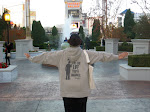Hopefully, the singular event of January 20, 2009 will result in a huge step in the direction of making Black History Month a memory of the past. I believe that will be up to us to help make that happen.
My contribution to helping make that happen and in keeping with the GOT ART? theme of my blog, is to introduce or re-introduce to you, some famous African American Artists throughout the month.
 Up first is Gordon Parks. Gordon Roger Alexander Buchanan Parks was born on November 30, 1912 (the youngest of 15 children) in segregated Fort Scott, Kansas.
Up first is Gordon Parks. Gordon Roger Alexander Buchanan Parks was born on November 30, 1912 (the youngest of 15 children) in segregated Fort Scott, Kansas.
Stillborn with no heartbeat, declared dead by the family doctor, and put aside for later burial, another doctor in the delivery room had an idea to immerse the newborn in ice-cold water. The shock caused his heart to start beating and the baby was soon crying, healthy, and named for Dr. Gordon, who had saved his life.
Gordon Parks was a ground-breaking American photographer, musician, poet, novelist, journalist, activist and film director.
At 25, Parks bought his first camera and began working as a self-taught freelance photographer, focusing on everything from fashion to the effects the depression in Chicago's slums. The photo clerks that developed his first roll of film applauded his work and prompted Parks to get a fashion assignment at Frank Murphy's women's clothing store. Every frame was double exposed with the exception of the one shot that caught Joe Louis' wife, Marva Louis' eye. Marva encouraged Parks to move to Chicago to begin a portrait business for society women.
By 1944, Parks was the only Black photographer working for Vogue and in 1948 he became the first Black photographer (for 20 years) at Life magazine, the most prestigious magazine of its day for photography.
Big Momma and Boy (Bessie and Little Richard the Morning After She Scalded Her Husband), 1967/8 Gordon Parks’s compelling photograph of Bessie Fontenelle and her youngest son Richard, Jr., was published by Life magazine on March 8, 1968, as part of a special feature on blacks and poverty called A Harlem Family (or At the Poverty Board). Parks’s essay and twenty-five photographs vividly depict the hardships of a Harlem family living under deplorable conditions. Taken shortly after Bessie violently retaliated against her husband’s abuse, this image, which appears on the opening spread, captures both her love for her son and her deep frustration and exhaustion—the dichotomy of a life torn between hope and despair. Her sadness is tempered by her child’s wide-eyed innocence. The article begins with this admonition: “What I want/What I am/What you force me to be/is what you are,” suggesting that we are all part of one global family. Sadly, only young Richard survived the family’s hardships and grew up to escape poverty.

Parks was the first African American to write, direct, and produce a film for a major motion picture company.
His film - The Learning Tree, was among the 25 films placed on the National Film Registry of the Library of Congress in 1989.
In 1966, Parks published the first of three autobiographies, A Choice of Weapons. This autobiography tells of his struggle to survive whole after his mother's death. Park's mother died when he was 15 years old.
Parks wrote many musical compositions, including blues tunes and popular songs in his early career, and frequently incorporated his music into his films. Conversely, he wrote several film scores and then adapted the music afterward for their separate release. Among these were Tree Symphony from The Learning Tree and "Don't Misunderstand" from Shaft's Big Score.
He composed Concerto for Piano and Orchestra, Piece for Cello and Orchestra, Five Piano Sonatas and Celebrations for Sarah Ross and Andrew Jackson Parks. He created the music and libretto for a five-act ballet entitled Martin in 1989. The ballet was a tribute to Martin Luther King Jr., which premiered in Washington, D.C. Martin later aired on national television on King's birthday in 1990.
Between 1968 and 1996, Gordon Parks received honorary degrees from the Maryland Institute of Fine Arts, Pratt Institute, Syracuse University School of Journalism, Boston University School of Public Communication, Colby College, Lincoln University, Rutgers University, Kansas City Art Institute in 1984, Art Center College of Design, Hamline University, American International College, Savannah College of Art and Design, and the University of the District of Columbia.
"I've known both misery and happiness, lived in so many different skins it is impossible for one skin to claim me. And I have felt like a wayfarer on an alien planet at times walking, running, wondering about what brought me to this particular place, and why. But once I was here the dreams started moving in, and I went about devouring them as they devoured me"
Gordon Parks died of cancer on March 7, 2006 at the age of 93 in New York City.








7 comments:
so wonderful to meet you..thanks for popping by and saying hello!!!
hugs
Diana
Wow Great feature of artist Gordon Parks.....the youngest of 15!? Uh, declared dead and put aside only to be put in ice water and saved by Dr. Gordon, that is truly amazing! And lived 93 years, again amazing.
Wonderful story, thanks for sharing :)
xo
I learned things about Gordon Parks I never knew ... like being stillborn, for example, thank goodness Dr. Gordon thought to put that baby in the ice water! Think what the world would have missed had he not done that. Thanks for the interesting lesson, I look forward to the next one.
-Sue
Fantastic post, loved the pictures. Happy Birthday!!
Excellent choice!
I love the post:)
I actually know of someone who photographed him!
Such talent - Gordan Parks....
I think I will do an AA story every so often... hmmmm
Post a Comment